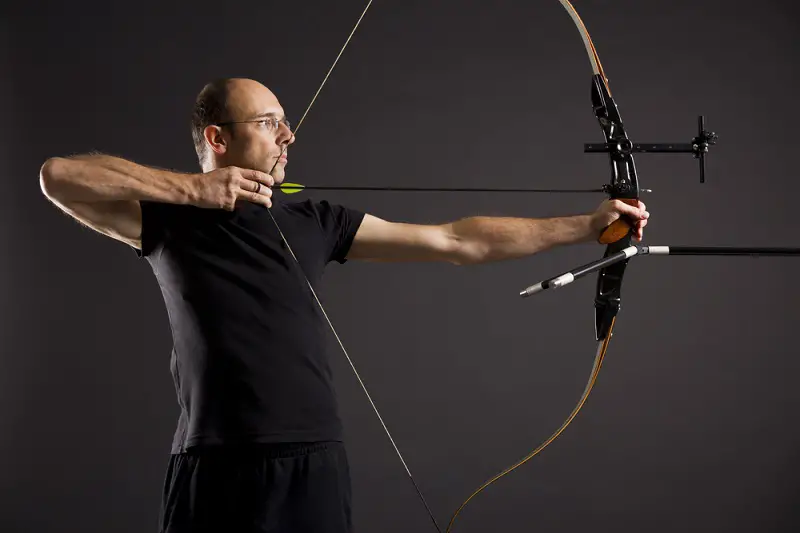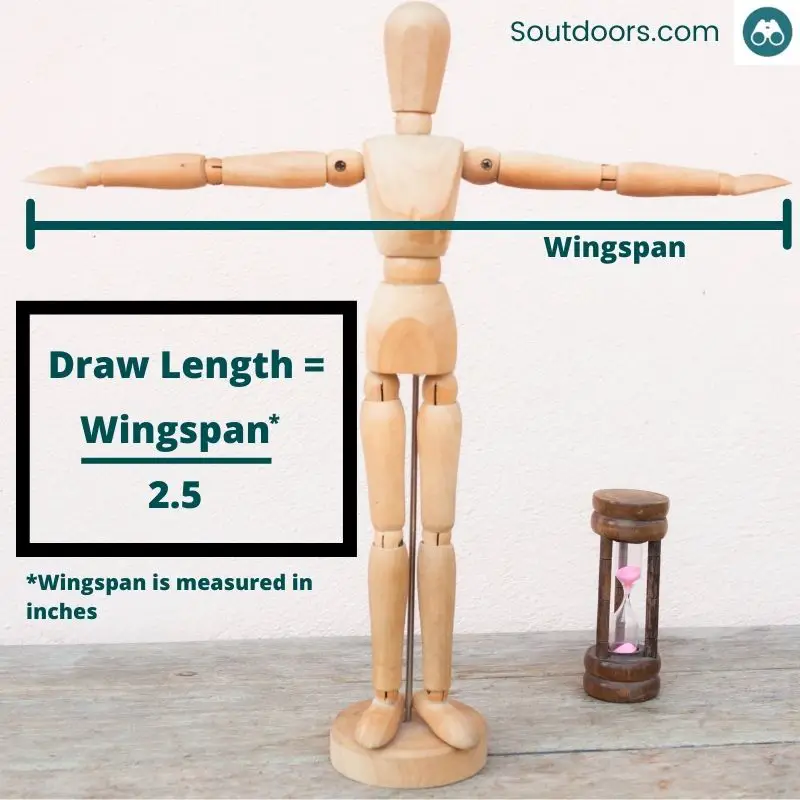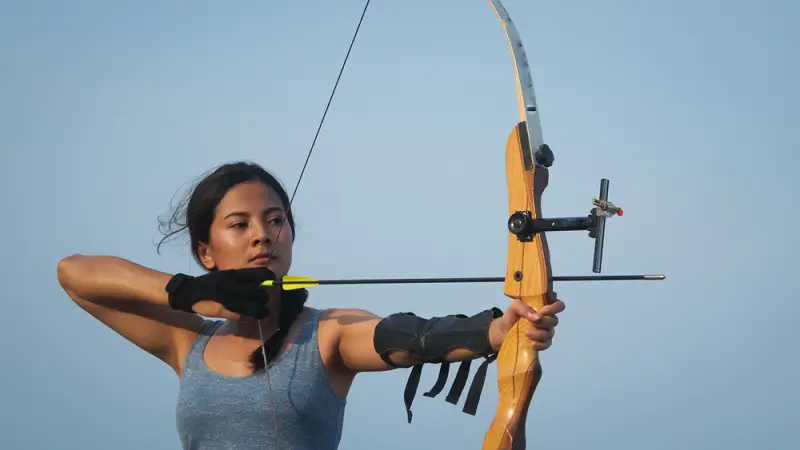
Your draw length is one of the most important measurements to know if you shoot archery, especially if you want to buy a new bow or set of arrows. Your draw length is essentially the distance you pull the bowstring back to your correct anchor point, measured in inches.
Knowing your draw length is essential when you’re shopping for a bow. A bow with an incorrect draw length will not shoot as accurately, will probably not feel comfortable to shoot, and may even injure your shoulders.
Knowing your draw length is important, but how do you figure it out? In this article, we’ll cover some important aspects of draw length, how to measure your draw length, and some other related topics and terms that will help you out.
Things to Know About Draw Length
There are a few things to know before we start covering the methods for measuring your draw length. These factors will help you understand the how-to section and give you a better understanding of draw length in general.
1. Your draw length may change
Your draw length may change throughout your archery career, and there are several reasons for this. If you, or a young archer that you’re helping, are not done growing yet, the appropriate draw length will change several times before reaching a final, set draw length.
Many youth bows have a wide draw length range that’s easily adjustable so that a growing archer doesn’t have to purchase a new bow every time they have a growth spurt.
Besides that, your draw length can change if you adopt a different anchor point, if your posture changes, or if you change the release aid you’re using. Your draw length changing isn’t something you will probably have to worry about often, but it can be a good thing to check if your shooting has felt off and you don’t know why.
2. Listed draw lengths aren’t the same from brand to brand
This is another minor detail that is important to keep in mind when bow shopping. When comparing bows from different brands, you may not have the same draw length in every brand. It’s usually not a huge difference, but you may notice that you need a bow that is half an inch or so different in Brand X than Brand Y.
This variance in lengths between different brands of bows is because different manufacturers will measure the draw length of their bows differently. You’ll probably also notice other differences between different brands when you try out bows, so it’s good to take note of all these differences so you can purchase the bow that fits your needs the best.
3. Draw length also matters for recurve bows
Many people think that draw length only matters when shopping for a compound bow. After all, compound bows have particular draw lengths, and recurve bows have none specified at all.
However, recurve bows come in different lengths. It’s important to know your draw length so that you can get a recurve bow that’s comfortable to shoot. Shooting a recurve bow that’s too short will be uncomfortable and can even shorten the bow’s lifespan as you pull the limbs back further than the manufacturer intended.
4. Your height doesn’t determine your draw length
A common archery misconception is that your draw length is directly related to your height, but this isn’t true. Taller archers will generally have a longer draw length, and vice versa, but this is actually because taller archers have longer arms.
The longer arms you have, the longer your wingspan will be. Your wingspan is the most significant factor in determining your draw length. So, taller people will tend to have a longer draw length, but their height is not exactly why.
How to Measure Your Draw Length
There are several different methods you can use to measure or estimate your draw length. We’ll walk you through a few methods that we like to use. We didn’t list these methods in any particular order, but some will work better than others in different situations.
It may even be helpful to try multiple methods and average the results together. You don’t need a bow to be able to measure your draw length, so you can try these methods at home or even before you own a bow.
Method 1: Measure from Wrist to Sternum
For this method, you’ll need a tape measure and a friend to measure for you. Hold your bow arm out like you’re about to shoot your bow, but turn your palm to face forward (like you’re trying to tell someone to stop). Have your friend measure from the end of your wrist to your sternum. Your is sternum in the center of your chest where the buttons on a shirt would be.
This measurement will give you a good approximation of your proper draw length. But, this measurement can be inaccurate if you have a significant difference in length between both of your arms.
Method 2: Measure from Mouth to Fist
This method is similar to the last, but it works better if you already have some experience drawing and shooting a bow. But, if you’re new to archery, or still not confident in your shooting form, this method might be inaccurate. Similar to the other method, you’ll need a tape measure and a friend to help you.
Hold your bow arm (the arm you grip your bow with) up like you’re about to shoot, and make a fist with that hand. Have your friend measure from the corner of your mouth to the end of your fist. This will give you a good approximation of your draw length.
Remember: The better you can replicate the form you use while shooting your bow, the more accurate this measurement will be.
Method 3: Wingspan Divided by 2.5

This is probably the most popular method of measuring draw length if you don’t have access to an archery shop with specialized tools to measure for you. You’ll need a tape measure and a friend to help you.
Hold your arms straight out to make your body look like a T, and turn your palms to face in front of you. Have your friend measure your wingspan in inches, from the middle finger on one hand to the middle finger on your other hand. Now take this measurement, and divide that number by 2.5.
This will give you an approximation of your draw length in inches.
Method 4: Wingspan Minus 15 Divided by 2
This is very similar to the last method. You will still need a measuring tape and a friend to help you measure.
First, put your arms out to the side so that your body forms a “T” and have your friend measure from fingertip to fingertip to get your wingspan in inches. Next, subtract 15 inches from your wingspan, and then divide that number by two.
This will give you another good approximation of your draw length. It can be helpful to use both this method and the previous one to compare and average the results. These two methods averaged together will give you the best approximation of your proper draw length.
Method 5: Have Your Draw Length Measured by an Archery Shop
This last method isn’t DIY, but if you have access to an archery shop, they can measure your draw length for you.
Different shops will use different equipment, but they’ll usually have you draw a lightweight bow back with a release that won’t allow you to fire the bow, like this Third Hand Can't Fire Release.
They’ll either have you draw the bow back with a special arrow with measurement markings on it or with a regular arrow that they can mark. When you have the bow drawn back, they’ll check the measurement or mark the arrow and then measure it to determine your proper draw length.
Having an archery shop measure your draw length for you can help if you aren’t confident doing it yourself. It’s also an excellent way to double-check the measurements you found yourself before you buy a bow.
Those are all of our preferred ways to estimate and measure draw length. We hope you found them helpful, and were able to figure out your proper draw length. If you’re still having trouble, we recommend trying two or more different methods and comparing the results you get.

Draw Length Measurement FAQs
How long should your draw length be?
There’s no one way to tell someone what their draw length should be. Your proper draw length will depend on several factors, the most significant being the length of your arms and where you anchor.
With that said, taller people will tend to have a longer draw length than shorter people. Archers that are well over six feet tall, or that have longer than average arms, may have around a 32-inch draw length.
Is my draw length too long?
It is hard to diagnose an incorrect draw length without seeing someone shoot, but there are a few signs that may point to you having an incorrect draw length:
- If you’re anchoring with your hand well behind your ear, your draw length is definitely too long.
- If you feel like you can’t get to a proper anchor point with your draw hand or you can’t get to a good contact point with your bowstring on your nose or mouth, your draw length may be too long.
- Another sign of an improper draw length is a bowstring that frequently hits your forearm after release. This can also be a sign of incorrect technique with your bow arm, and also painful.
What about with a recurve bow? Since recurve bows don’t have a set draw length, you technically can’t have an incorrect draw length. If you feel like you’re drawing your recurve bow too long, the best thing to do is check that you’re coming to the same solid repeatable anchor point on every shot.
How long should my arrows be for a 29-inch draw?
You might think that you need arrows that are 29 inches long for a 29-inch draw length bow. While 29-inch arrows may technically work, it may be unnecessarily hard to keep them from falling off your arrow rest. You’ll probably want arrows that are at least an inch longer, which would be 30 inches long for a 29-inch draw length.
You may find that even longer arrows work better for your setup, though. Many factors determine how well an arrow will shoot out of your bow, and sometimes an arrow will fly much better if you leave it longer than usual. Leaving an arrow longer will make it act like it has a weaker dynamic spine. Don’t know what dynamic spine is? Check out our Arrow Guide here for the answers to all of your arrow questions.
How do you measure arrow length?
Arrows are usually measured “carbon to carbon,” which means that the shaft is the only part measured. You don’t count any length added by the arrow point, inserts, or the arrow nock. Inches are the preferred unit of measurement.
Glossary
Bow Arm – The arm you hold and grip your bow with. For right-handed archers, it is your left hand. For left-handed archers, it is your right hand.
Draw Length – The technical definition is the distance from your arrow nock to your bow grip’s throat, plus 1 ¾ inches. The listed draw length on a compound bow is the distance you can pull the bowstring back until it stops.
Wingspan – With your arms held out to your sides like a “T,” your wingspan is the distance from the tip of your middle finger to the tip of your other middle finger. It is a useful measurement to know when trying to determine your proper draw length.
